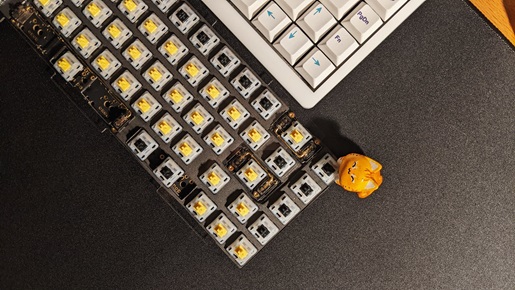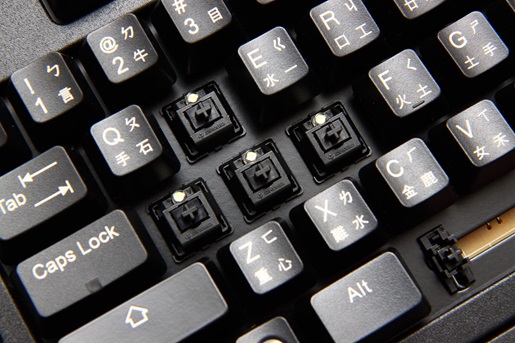Turn typing session into symphonies with these joyfully noisy switches
If you love a hobby, you want to tell people about it, right? And mechanical keyboards certainly are a passion worth spreading the word about. But if you pick the right key switches, you won’t even have to open your mouth to let everybody in your home or office (and maybe even the people next door) know how much you love them. We’re talking, of course, about the loudest mechanical keyboard switches available on the market today.
This guide will introduce you to the pieces of a keyboard that make it sound louder in action, then lay out five mechanical keyboard switches ideal for those who consider loud-and-proud presses to be a positive, not a negative. We’ll even include links for where to buy them. But first, a disclaimer: Installing these switches in your daily driver board without consulting your partner, roommates, or co-workers first may lead to regrettable changes in your domestic and/or professional circumstances. Please click responsibly.
Check out our comprehensive guide to the world of mechanical keyboard switches.
What determines the volume of mechanical keyboard switches?
Many advancements have been made to create more quiet mechanical keyboard switches, allowing people to enjoy satisfying typing without the characteristic chattiness of mechanical keyboards. Thankfully for typists who want to go loud, advancements have been made in the other direction too. Granted, few switch designers target decibel output as the driving force in their creations, but moves toward improved tactility and keypress feel often make those mechanical keyboard switches sound louder too.
Here are three factors to pay attention to as you hunt for the perfect noise level:
- Internal components: The internal design of the switch plays a massive part in how loud it sounds. So-called “clicky” switches tend to be the loudest because they feature an extra piece specifically built to elicit a noise and tactile sensation on keypresses: either a click bar that makes sounds when the switch is actuated and released or a click jacket that only makes a sound on actuation.
- Lubrication, or lack thereof: Mechanical keyboard enthusiasts have long recommended disassembling switches and lubricating them for improved sound and feel (some high-end switches even come pre-lubricated). Lubed switches do tend to be quieter, but applying lubricant to only certain moving parts, such as the spring, can make a switch feel better and reduce undesired elements of noise without substantially diminishing its sound.
- The rest of the board: Your switches are a single part of the symphony. Just like a classical performance needs a suitable concert hall, the sound of your keys can be enhanced or reduced by your choice of keyboard frame and whether you install or eschew sound-dampening components.
Driven tinkerers can go even further with keyboard mods, such as installing a solenoid driver to recreate that classic electric typewriter chatter. This guide wouldn’t be complete without an honorable mention for the commanding peal of buckling spring keyboards — though sadly their unique design means you can’t simply drop them into a mechanical keyboard you already own.
Did You Know?:Want to pick up a pre-built keyboard that’s perfect for making some noise? Check out our guide to the loudest mechanical keyboards.
The 5 loudest mechanical keyboard switches
Now that we know what makes some mechanical keyboard switches sound louder than others, it’s time to dive into examples you can use to augment your typing experience ASAP.
For classic character: Cherry MX Green
If you’ve spent much time in the mechanical keyboard space you’re likely familiar with Cherry MX Blue switches — the archetypal clicky switch. While there’s nothing wrong with a good set of Blues, if you’re going after satisfying sound, you’ll be even better served by dropping in some Cherry MX Greens. Their higher actuation force (meaning you have to press them harder for a keypress to register) and click jacket design translate to a single, crisp sound that’s satisfying for seasoned typists who like to really put their back into their writing, programming, or gaming. You can pick up a set of 10 for $3.99.
For maximum sound and tactility: Kailh Box Jade
Manufacturer Kailh introduced click bars for its Box line of switches. If you aren’t so concerned with what’s going on inside your switch of choice, the reason that distinction matters is because bars give you twice the clickiness of click jackets: one click on the downstroke, and one click on the return. Keen-eared enthusiasts also say clickbars allow for a cleaner sound, without the rattle that click jackets can lend to the audible character of a switch. Kailh makes some of the most accessibly priced switches in the business, with a set of 36 going for $12.24, working out to $3.40 per ten switches.
For a unique click: Chosfox x Kailh Arctic Fox
Another Box switch from Kailh, Arctic Foxes were designed by boutique mechanical keyboard company Chosfox to render a new take on the clicky formula. While they also use a clickbar to generate the bulk of their unique sound, Arctic Fox switches make a mechanical keyboard switch sound all their own. Listen closely to the sound test above and you’ll hear what we could only describe as a light and airy metallic sound that isn’t hollow, nor overbearing. You can pick up a set of 30 from Chosfox for $16.20, which translates to $5.40 for every 10.
For the loudest tactile: Everglide Dark Jade
All of the switches we’ve listed so far can be classified as “clicky,” because their sound-enhancing design will always set them apart in terms of raw volume. But if you want to try some of the other ways switches can feel and sound while still hearing each keypress, you should try out the tactile joy of Everglide Dark Jades, AKA Moyu Black switches. Though it features a strong tactile bump, the noisiest part of the switch actually comes at the deepest part of its travel when it “bottoms out” with a resonant and bassy sound. It’s fair to say these are more niche switches and they’re priced to match, with a set of 10 going for $10.90.
For the loudest linear: Zeal Tealios V2
“Hold the phone,” we hear you saying, “Aren’t linear switches supposed to be quiet?” You’re right. Out of the three main archetypes of switches, linears — due to their lack of clicking parts or even a tactile bump — tend to be the most conducive to covert computing. But that doesn’t mean the other aspects of a switch’s design can’t make one linear noisier than the next. And if you’re the kind of person who loves the smooth feeling of a linear switch, but just wishes you could hear yourself type a little bit better, the Zeal Tealios V2s are your noisy little huckleberries. You’ll hear them best if you tend to bottom out the keys as you type, but even if not, they’ll still serenade you with a pleasant little pop on every press. They’re just a hair more expensive than Dark Jades, at $11 for a box of 10 switches.
Bonus: Topres for a resounding thock
We’re not going to try to tell you that Topre switches are some of the loudest mechanical keyboard switches on the market. But if you’re the kind of person that truly values all the wonderful noises that keyboard can elicit, you need to try the one-of-a-kind “thock” of a Topre. Since they have a non-MX format all their own, the easiest (and we may even say best) way to take on a full set of Topre switches is on an HHKB Professional HYBRID keyboard.
The full line of high-end keyboards from HHKB is distinguished by its desk-friendly, space-saving design, intelligently revised layout, and the joy of those electrostatic capacitive switches: no key chatter or rattle, just thock.












